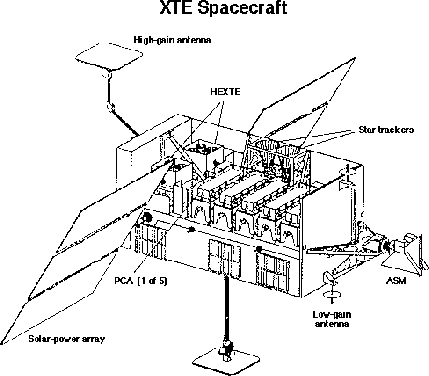 |
![[*]](crossref.png) )
is an experiment on board
the Rossi X-ray Timing Explorer (Rossi-XTE) satellite
)
is an experiment on board
the Rossi X-ray Timing Explorer (Rossi-XTE) satellite
![[*]](footnote.png) ([Bradt et al., 1993,Swank et al., 1998,Bradt et al., 2001]), launched on December 30, 1995.
It consists of three wide-angle shadow cameras equipped with
proportional counters with a total collecting area of 90 cm
([Bradt et al., 1993,Swank et al., 1998,Bradt et al., 2001]), launched on December 30, 1995.
It consists of three wide-angle shadow cameras equipped with
proportional counters with a total collecting area of 90 cm
Two cameras point normally to the rotation axis to the same direction,
so that their error boxes cross each other, therefore reducing the
positioning error to
![]() for weak sources
and to
for weak sources
and to
![]() for stronger sources;
it has a 20 mCrab sensitivity.
the third camera points along the rotation axis.
Each observation lasts about 100 s; then, the next pointing is obtained
with a
for stronger sources;
it has a 20 mCrab sensitivity.
the third camera points along the rotation axis.
Each observation lasts about 100 s; then, the next pointing is obtained
with a ![]() rotation and so on, untill a complete rotation is performed
(every 100 min), during which
rotation and so on, untill a complete rotation is performed
(every 100 min), during which ![]() 80% of the whole sky has been monitored.
This capability in monitoring possible X-ray transients and variations
in flux of known sources, like CygX-1, makes the ASM experiment suitable
for detecting GRBs; nevertheless, the small collecting area and the small
field of view limit the number of localized bursts.
Moreover, when a GRB is within the field of view of one camera, its
direction is known only along one dimension, given the large width (
80% of the whole sky has been monitored.
This capability in monitoring possible X-ray transients and variations
in flux of known sources, like CygX-1, makes the ASM experiment suitable
for detecting GRBs; nevertheless, the small collecting area and the small
field of view limit the number of localized bursts.
Moreover, when a GRB is within the field of view of one camera, its
direction is known only along one dimension, given the large width (
![]() )
of the error strip; therefore, although it cannot precisely locate GRBs
by itself, nevertheless it can be very important in reducing the error
box, when other experiments detected the same burst: this occurred in
several cases ([Smith et al., 1999]).
)
of the error strip; therefore, although it cannot precisely locate GRBs
by itself, nevertheless it can be very important in reducing the error
box, when other experiments detected the same burst: this occurred in
several cases ([Smith et al., 1999]).